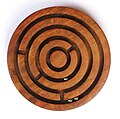The Toys Portal

A toy or plaything is an object that is used primarily to provide entertainment. Simple examples include toy blocks, board games, and dolls. Toys are often designed for use by children, although many are designed specifically for adults and pets. Toys can provide utilitarian benefits, including physical exercise, cultural awareness, or academic education. Additionally, utilitarian objects, especially those which are no longer needed for their original purpose, can be used as toys. Examples include children building a fort with empty cereal boxes and tissue paper spools, or a toddler playing with a broken TV remote. The term "toy" can also be used to refer to utilitarian objects purchased for enjoyment rather than need, or for expensive necessities for which a large fraction of the cost represents its ability to provide enjoyment to the owner, such as luxury cars, high-end motorcycles, gaming computers, and flagship smartphones.
Playing with toys can be an enjoyable way of training young children for life experiences. Different materials like wood, clay, paper, and plastic are used to make toys. Newer forms of toys include interactive digital entertainment and smart toys. Some toys are produced primarily as collectors' items and are intended for display only. (Full article...)
Selected article -
Lego (/ˈlɛɡoʊ/ ⓘ, LEG-oh; Danish: [ˈle̝ːko]; stylised as LEGO) is a line of plastic construction toys manufactured by the Lego Group, a privately held company based in Billund, Denmark. Lego consists of variously coloured interlocking plastic bricks made of acrylonitrile butadiene styrene (ABS) that accompany an array of gears, figurines called minifigures, and various other parts. Its pieces can be assembled and connected in many ways to construct objects, including vehicles, buildings, and working robots. Assembled Lego models can be taken apart, and their pieces can be reused to create new constructions.
The Lego Group began manufacturing the interlocking toy bricks in 1949. Moulding is done in Denmark, Hungary, Mexico, and China. Brick decorations and packaging are done at plants in the former three countries and in the Czech Republic. Annual production of the bricks averages approximately 36 billion, or about 1140 elements per second. One of Europe's biggest companies, Lego is the largest toy manufacturer in the world by sales. As of July 2015[update], 600 billion Lego parts had been produced. (Full article...)
General images -
Selected image

A teddy bear formerly owned by Kermit Roosevelt, thought to be made by Michtom, early 1900s; Smithsonian Museum of Natural History, 2012
Did you know...
- ... that Taylor Swift released a demo containing lyrics that were trimmed from the final version of her song "My Boy Only Breaks His Favorite Toys"?
- ... that before becoming a voice actor, Kikunosuke Toya was the keyboardist of an all-male Princess Princess cover band in high school?
- ... that "Toy Town" was said to have "almost destroyed" the happy hardcore scene?
- ... that the design for the water playground at Chelsea Waterside Park was criticized because local residents thought that the sprinklers resembled sex toys?
- ... that Korean brick toys, colloquially called "Korean Lego", often feature themes of "war and danger", including sets such as military vehicles?
- ... that Elizabeth II's childhood toys at 145 Piccadilly included 30 toy horses and a farm set collected from Woolworths?
- ...that Amish dolls (pictured) are left faceless, possibly to emphasize that "all are alike in the eyes of God"?
- ...that the first themed Lego Modular Houses set, released in April 2007, was designed for people aged 16 and older and meant to be "toys for adults"?
- ...that children up to the age of five can find it difficult to distinguish between television programmes and toy advertising campaigns?
Subcategories

Related portals
Topics
Types: • Doll • Vehicle • Puzzle • Teddy bear
Industry: • American Specialty Toy Retailing Association • Birmingham toy industry • International Union of Allied Novelty and Production Workers • Kiddicraft • Play value • Toy safety • Toy store • Toyetic • Wooden toymaking in the Ore Mountains
WikiProjects
- Parent projects
- Arts • Entertainment • Visual arts • Games
- Main project
- Toys
- Sub-projects
- Board and table games • G.I. Joe • Transformers • My Little Pony
- Related Projects
- Animation • Anime and manga • Biography • Comics • Film • Fictional characters • Media franchises • Music • Television • Video games
Things you can do
edit · history · watch · purge
 |
Here are some tasks awaiting attention:
|
Associated Wikimedia
The following Wikimedia Foundation sister projects provide more on this subject:
-
Commons
Free media repository -
Wikibooks
Free textbooks and manuals -
Wikidata
Free knowledge base -
Wikinews
Free-content news -
Wikiquote
Collection of quotations -
Wikisource
Free-content library -
Wikiversity
Free learning tools -
Wiktionary
Dictionary and thesaurus



















































